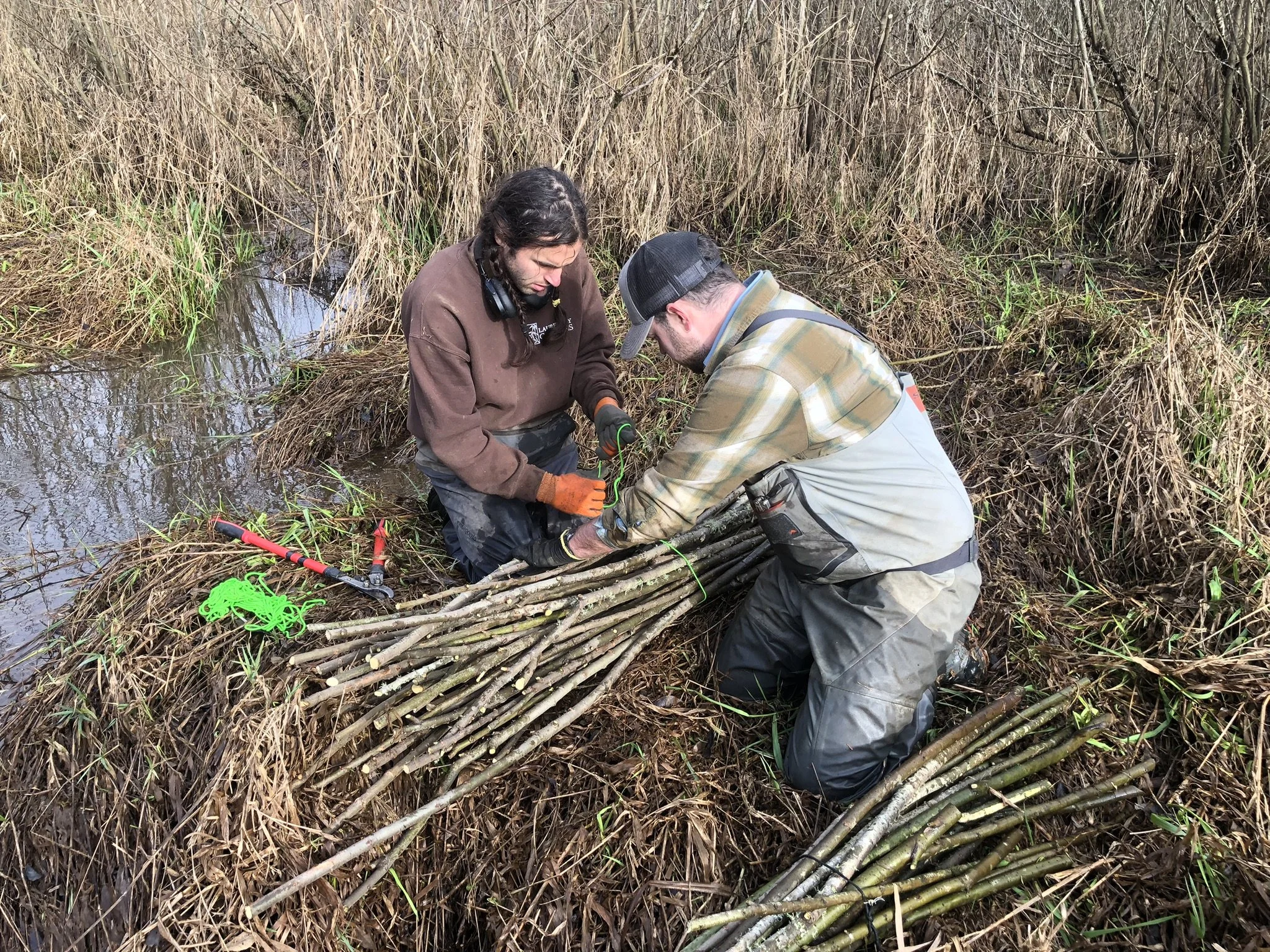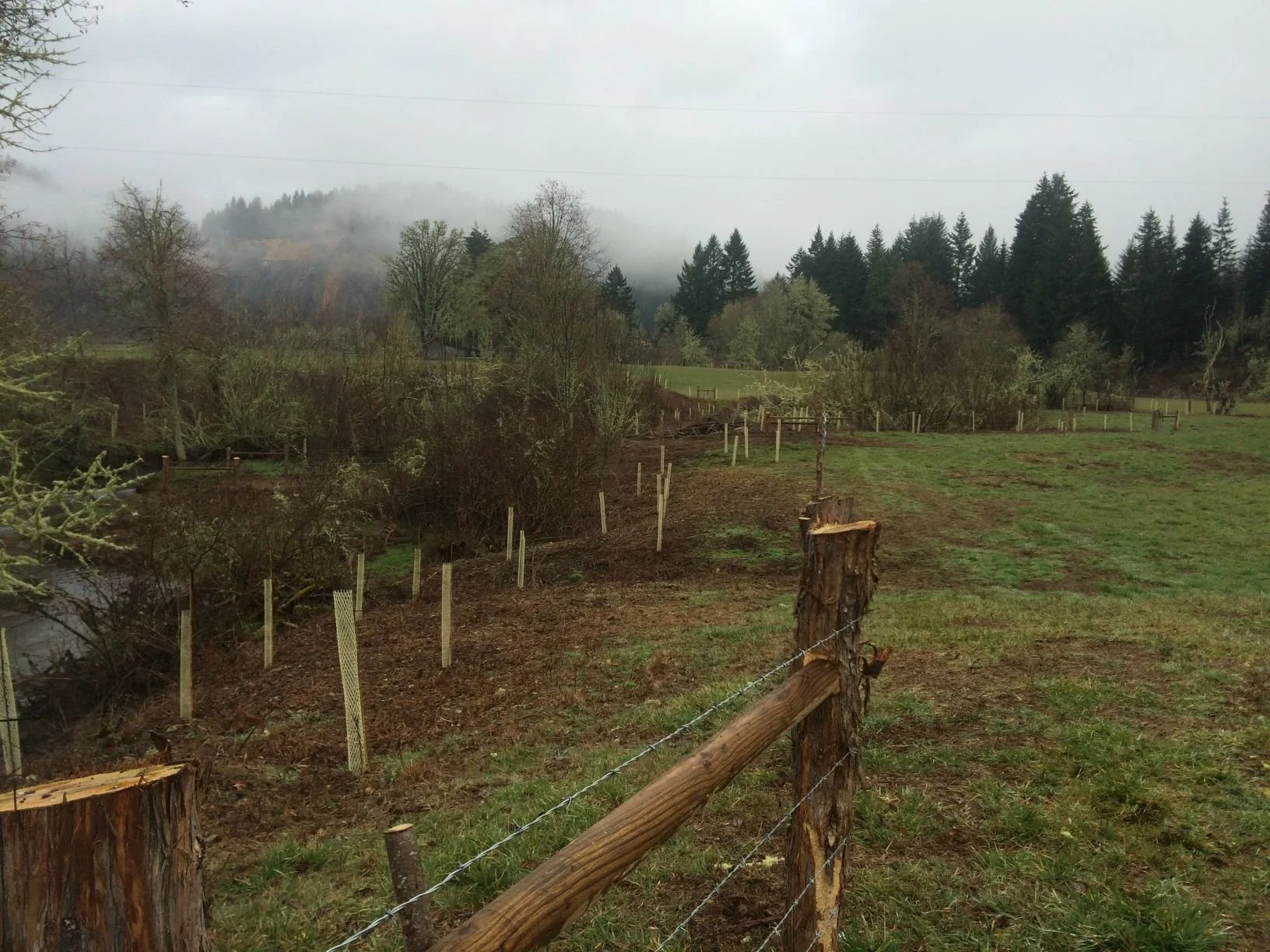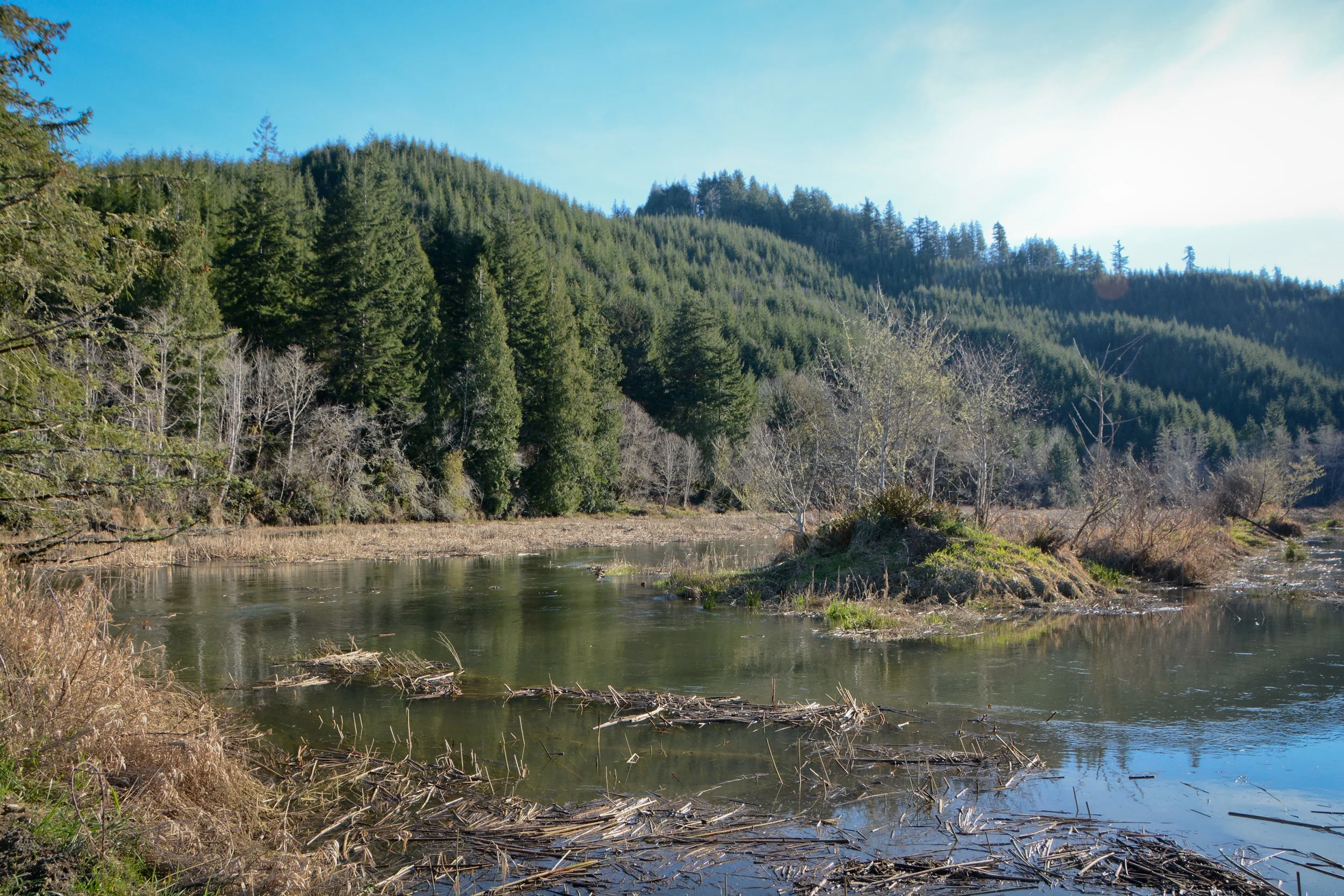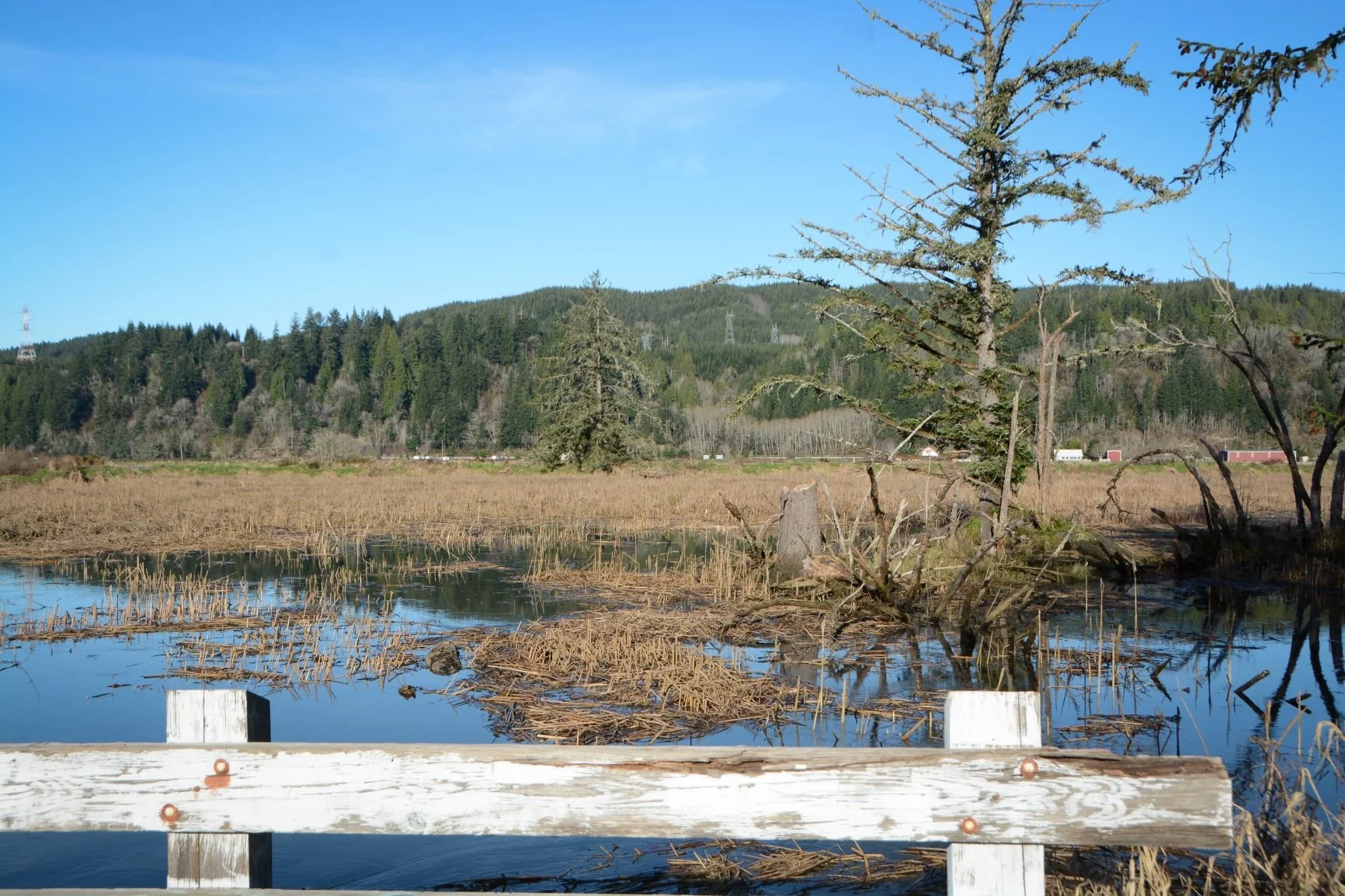Current Projects
Click on the photos below to learn more about what we're doing with our partners to restore the Siuslaw and Coastal Lakes watersheds to benefit our communities, economy, environment and future generations.
North Fork Helicopter Large Woody Debris Project
This 2018 project improved salmon habitat by using a heavy-lift helicopter to add whole trees to streams in the North Fork Siuslaw sub-watershed.
In the Siuslaw watershed of hundreds of years ago, valley bottoms were full of braided streams, running through and around live tree, shrub, and plant communities, and large downed trees and log jams. They were shady, difficult to travel through, and full of sheltered places for juvenile fish to safely spend time growing and preparing for the long journey ahead of them. Over the course of the last two hundred years, land use practices have resulted in simplification of the stream channels, often creating single channels of fast-moving water, tall banks with no vegetation, and homogenous streambed materials. This change negatively impacted the quantity and quality of habitat supporting Coho salmon, and resulted in limitations on the population. Adding large wood to streams helps complex habitat develop that is capable of supporting larger Coho populations.
The North Fork Siuslaw large woody debris (LWD) project included placement of nearly 400 large trees, most with root wads, using a helicopter, into five significant tributary streams to the North Fork Siuslaw River: Wilhelm, Drew, Uncle, Condon, and Billie Creeks. A total of approximately 8 miles of stream reaches were treated, all on national forest land. The five project area are anadromous, fish-bearing streams with high intrinsic potential for Coho salmon, and have been identified as high priority habitat restoration areas by local, state, and federal entities. Surveys in project streams identified a lack of sufficient wood needed to create and maintain pools, retain and sort sediments, and generate connectivity with the floodplain, all key components of high quality winter rearing habitat. The addition of wood during this project is complemented by the land management of the surrounding floodplain and uplands, where the Siuslaw National Forest is working to develop a landscape that naturally contributes additional wood to the streams, supporting future high-quality Coho habitat.
Project partners included the Siuslaw National Forest, the Confederated Tribes of the Coos, Lower Umpqua, and Siuslaw Indians, and the contractors on the project: Bateman Forestry Management, MBL Timber Services, and Columbia Helicopters.
Five Mile Bell Stage 0 Restoration Project
A large-scale restoration of watershed processes on tributaries to Tahkenitch Lake.
Fivemile and Bell Creeks form the largest tributary to Tahkenitch Lake on the Central Oregon Coast, 11 air miles south of Florence. These streams historically supported some of the strongest runs of Oregon Coast Coho salmon. In 2003, the Forest Service acquired significant portions of the sub-basin with the goal of restoring watershed functions and Oregon Coast Coho salmon runs. In a collaboration of many other partners, SWC manages the riparian revegetation component of the 4.5 mile restoration project along the two streams.
The 112-acre project site was once a complex, interbraded stream channel that flooded its banks regularly during the rainy season. Wetland plant communities grew on small islands separating many channels that slowly meandered across the 400-foot-wide floodplain, creating ideal rearing habitat for young Coho salmon. By the 1950’s ranchers had straightened and consolidated these complex channels down to one larger channel pushed against the side of the valley andwetland plant communities were converted to pasture grasses so dairy cattle could graze the floodplain.
Site remediation began with restoring the native plants to Fivemile-Bell beginning in ‘Phase I’ during 2011. Prior to planting, our partners at the Forest Service and The Siuslaw Institute removed the levees that kept Fivemile Creek locked in place. With the channel restored to its complex form, SWC could reintroduce the natural wetland plant communities that help sustain healthy Coho populations and biodiversity.
Since the project began in 2011, SWC and partners have implemented four phases of restoration in the valley. The final regrading was completed in 2018 but the establishment of native vegetation is expected to continue through 2022.
haich ikt’at’uu (formerly Waite Ranch) Tidal Wetland Restoration Project
Restoring tidal influence from the Siuslaw River to 200 acres of land in the Siuslaw estuary.
For information on this project, please see McKenzie River Trust's page here: https://mckenzieriver.org/property/haich-iktatuu/
Cleveland Creek Railroad Culvert Replacement Project
This 2015 project removed a failed culvert that conveyed Cleveland Creek under the railroad and replaced it with a bridge, allowing access for fish
Cleveland Creek enters the mainstem Siuslaw River three miles northeast of Mapleton, Oregon, passing under the Coos Bay Rail Link railroad and under Oregon Highway 36 near the confluence with the Siuslaw. A 2004 survey of stream crossings in the Siuslaw identified the culvert that carried Cleveland Creek beneath the railroad line as a complete barrier to fish passage, and a high priority for replacement. The culvert was located near the mouth of Cleveland Creek, with 1.5 miles of habitat for Oregon Coast Coho salmon, winter steelhead, and sea-run cutthroat trout located upstream of the culvert. In addition to its potential to provide spawning and rearing habitat, Cleveland Creek was also identified as providing cold-water refuge for salmonids along a stretch of the Siuslaw River that is too hot for juveniles during the summer months.
Hawley Creek Restoration Project
Riparian fencing, planting, and enhancement to pond turtle habitat.
Hawley Creek is a tributary of the Upper North Fork of the Siuslaw River that enters the mainstem in Lorane. This part of the Siuslaw Watershed is geographically distinct. Landforms and settlement patterns are similar to the Southern Willamette Valley. Low, rounded hills frame broad, level valleys that historically were camas prairies with black cottonwood and Oregon ash. Oak and pine edge these prairie valleys, giving way to Douglas and grand fir on the hillslopes. Coho salmon and western pond turtles inhabit lower Hawley Creek where SWC began restoration with a committed landowner in 2013. We’ve been working together since then to ensure that the creek running through their property is a healthy stream for aquatic species and can support salmon in the upper reaches of the Siuslaw watershed.
The 2013 restoration started with the placement of 19 logs for turtle basking. Over the next three years, 11 nesting mounds were created, 2.8 miles of streambank were fenced, 2.3 miles of invasive weeds were treated, and over 5,000 native hardwoods, shrubs, and forbes were planted on 6.2 acres. The private landowner employed local crews to assist with the planting and maintenance. Supplemental planting was done through the SWC Native Plant Distribution program and the site illustrates what can be accomplished on private land with the right landowner and partners. We expect to complete plant maintenance at Hawley Creek in 2019.
Karnowsky Creek Restoration Project
Re-meandering a valley-bottom stream for improved wetland habitat.
Karnowsky Creek was the predecessor to the Fivemile-Bell project. The stream flows into the Siuslaw River Estuary, just nine miles from the Pacific Ocean. In the late 1800s this valley was home to pioneers who cleared trees from the valley floor, farmed and tended livestock, hunted wildlife, and harvested large cedar trees to build homes and barns. Grandchildren of the first settlers testify that a steam locomotive once made its way up through the valley to transport logs harvested from the hill slopes. They speak of harsh winters, frequent floods and the hard work it took to control the stream in their valley. The total area of Karnowsky Creek watershed is 1800 acres and is comprised of 1716 acres of steep forested hillsides and 93 acres of flat valley bottom pasture.
In 2001, Forest Service and SWC began designing a project that would attempt to restore historic hydrology, aquatic resource populations, and native plant communities within the valley. With the addition of the Siuslaw Soil and Water Conservation District, the team began construction of a new, meandering channel and helicopter placement of whole logs began in 2002-03. The goals of the project were to restore natural meander geometry, raise the water table and extent of associated wetlands, restore riparian plant communities, encourage floodplain connection, and add large wood to the channel and valley floor. Most of the restoration in the Karnowsky valley ended in 2008 when the last release was completed on riparian plantings.













